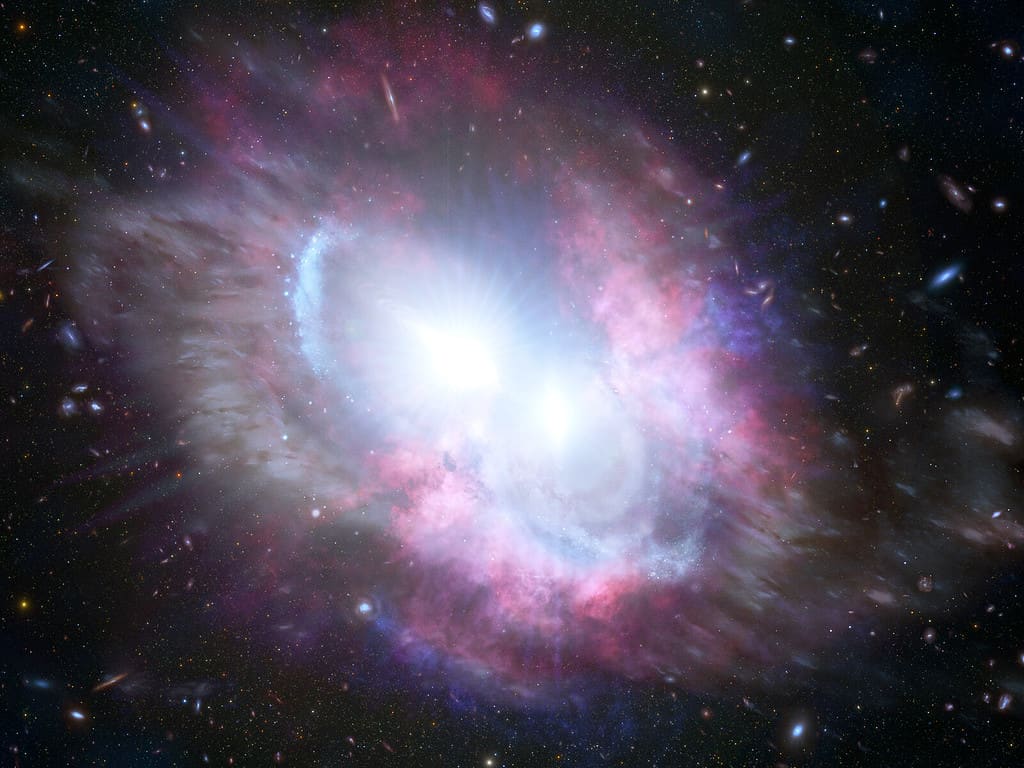
In a remarkable discovery, a team of astronomers has unearthed a pair of quasars, nestled within two colliding galaxies that date back to the universe’s infancy, just three billion years after the Big Bang. The quasars were situated so closely that their distance was less than that between two galaxies.
Quasars are powered by supermassive black holes that consume gas, dust, and everything else within their gravitational reach, emitting a substantial amount of energy in the process. As these black holes merge, they form even larger supermassive black holes that sit at the centers of galaxies.
Double trouble in the early Universe
The European Space Agency’s Gaia space observatory was the first to detect the binary quasars, and further evidence was gathered using the combined power of several observatories, including the NASA Hubble Space Telescope, W.M. Keck Observatory, International Gemini Observatory, the Karl G. Jansky Very Large Array, and NASA’s Chandra X-ray Observatory.
This finding is particularly exciting because double quasars are exceedingly rare at this early stage of the universe’s evolution. By understanding the precursor black hole population, this discovery can provide valuable insights into the emergence of supermassive black holes and the frequency of their mergers.
“We don’t see a lot of double quasars at this early time. And that’s why this discovery is so exciting,” said graduate student Yu-Ching Chen of the University of Illinois at Urbana-Champaign, lead author of this study, published in Nature. “Knowing about the progenitor population of black holes will eventually tell us about the emergence of supermassive black holes in the early Universe, and how frequent those mergers could be.”
The emergence of close binary quasars is a relatively new area of research, which has been made possible by the latest powerful observatories that enable astronomers to identify the coexistence of two quasars simultaneously, close enough to eventually merge and create new, much larger galaxies.
The researchers used a novel technique that involved the Gaia observatory to locate potential binary quasar candidates. Gaia measures the precise position, distance, and motion of nearby celestial objects, but this technique allowed it to explore the distant universe. Gaia’s colossal database can search for quasars that appear to mimic the motion of nearby stars.
Even though the quasars appear as single objects in the Gaia data, they are so close that they create a subtle, unexpected “jiggle” that mimics a shift in the position of the quasars. However, this jiggle may indicate random fluctuations in light as each member of the quasar pair varies in brightness on timescales of days to months, depending on their black hole’s feeding schedule.
One of the significant challenges in detecting binary quasars is that gravity bends space, much like a funhouse mirror. Consequently, a foreground galaxy could split the image of a distant quasar into two, creating the illusion that it is a binary pair. To rule out this possibility, the Keck telescope was used to ensure that there were no lensing galaxies between us and the suspected double quasar.
The forthcoming NASA Nancy Grace Roman Space Telescope, with the same visual acuity as the Hubble telescope, is ideal for hunting binary quasars. While Hubble has been used to collect data on individual targets, Roman’s wide-angle infrared view of the universe is 200 times larger than Hubble’s.
“We’re starting to unveil this tip of the iceberg of the early binary quasar population,” said University of Illinois astronomy professor Xin Liu. “This is the uniqueness of this study. It is actually telling us that this population exists, and now we have a method to identify double quasars that are separated by less than the size of a single galaxy.”









